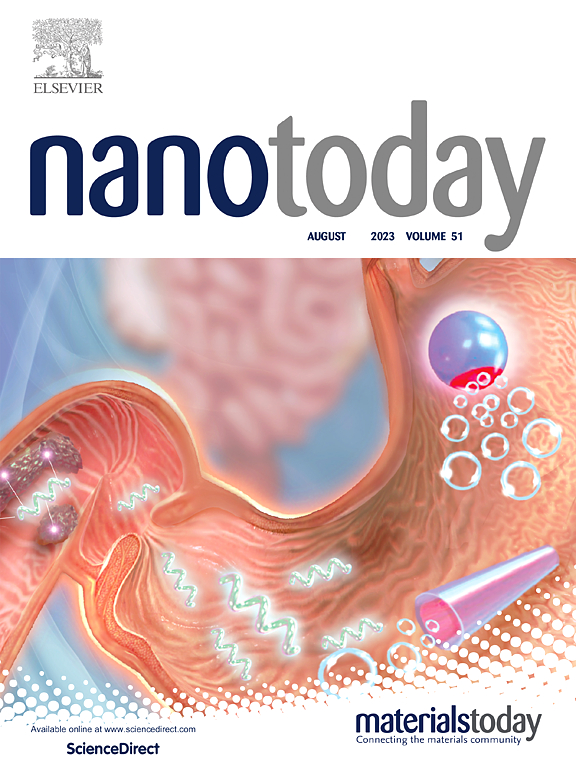等离子体合金增强代谢指纹图谱用于心肌梗死的快速诊断和分类
IF 13.2
1区 材料科学
Q1 CHEMISTRY, MULTIDISCIPLINARY
引用次数: 0
摘要
虽然心肌肌钙蛋白(cTn)是一种推荐的心肌梗死(MI)临床生物标志物,但它对于需要连续测量cTn的MI诊断是低效的,并且对于MI亚型识别是不准确的。先进的生物分析平台通常依赖于具有定制结构和成分的材料。本研究构建多孔PtAu合金,通过激光解吸/电离质谱(LDI-MS)有效提取血清代谢指纹图谱(SMFs),通过SMFs的机器学习实现MI的准确诊断和分类。PtAu合金表现出增强的代谢物检测,优于单金属纳米颗粒和有机基质。这归因于多孔结构、增强的光电流响应、电磁场和光热转换。smf的机器学习得到了604名来自多个中心的受试者在一次血清测试中的曲线下面积(auc)为0.941-1的诊断模型,克服了连续cTn测量的临床低效率。特别是,我们的平台实现了对1型、2型心肌梗死和心肌损伤患者的准确区分,最大AUC为0.905,优于cTn生物标志物。值得注意的是,MI的诊断和分类可以在~ 30 min内完成。我们的平台有可能减少在急诊科花费的时间,并改善心肌梗死的治疗。本文章由计算机程序翻译,如有差异,请以英文原文为准。
Plasmonic alloys enhance metabolic fingerprints for rapid diagnosis and classification of myocardial infarction
Although cardiac troponin (cTn) is a recommended clinical biomarker of myocardial infarction (MI), it is inefficient for MI diagnosis requiring serial cTn measurements and is inaccurate for MI subtype identification. Advanced bioanalytical platforms commonly rely on materials with tailored structure and composition. Here, we construct porous PtAu alloys to effectively extract serum metabolic fingerprints (SMFs) via laser desorption/ionization mass spectrometry (LDI-MS), achieving accurate diagnosis and classification of MI by machine learning of SMFs. The PtAu alloys demonstrate enhanced metabolite detection, superior to the monometallic nanoparticles and organic matrix. It is attributed to the porous structure, enhanced photocurrent response, electromagnetic field, and photothermal conversion. Machine learning of SMFs yields diagnostic models with the area under curves (AUCs) of 0.941–1 for 604 subjects from multiple centers in a serum test, overcoming the clinical inefficiency for serial cTn measurements. In particular, our platform achieves accurate discrimination among patients with type 1 MI, type 2 MI, and myocardial injury, with a maximum AUC of 0.905, outperforming the cTn biomarker. Notably, the diagnosis and classification for MI can be finished within ∼30 min. Our platform has the potential to reduce time spent in the emergency department and improve treatment for MI.
求助全文
通过发布文献求助,成功后即可免费获取论文全文。
去求助
来源期刊

Nano Today
工程技术-材料科学:综合
CiteScore
21.50
自引率
3.40%
发文量
305
审稿时长
40 days
期刊介绍:
Nano Today is a journal dedicated to publishing influential and innovative work in the field of nanoscience and technology. It covers a wide range of subject areas including biomaterials, materials chemistry, materials science, chemistry, bioengineering, biochemistry, genetics and molecular biology, engineering, and nanotechnology. The journal considers articles that inform readers about the latest research, breakthroughs, and topical issues in these fields. It provides comprehensive coverage through a mixture of peer-reviewed articles, research news, and information on key developments. Nano Today is abstracted and indexed in Science Citation Index, Ei Compendex, Embase, Scopus, and INSPEC.
 求助内容:
求助内容: 应助结果提醒方式:
应助结果提醒方式:


